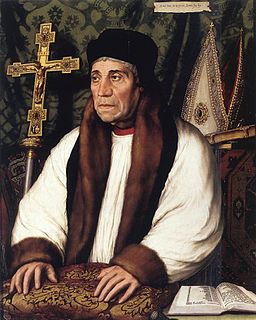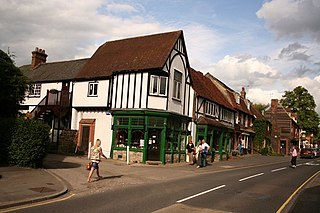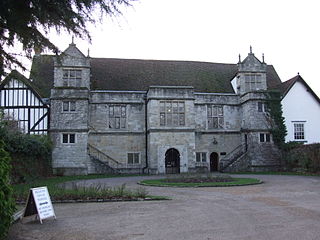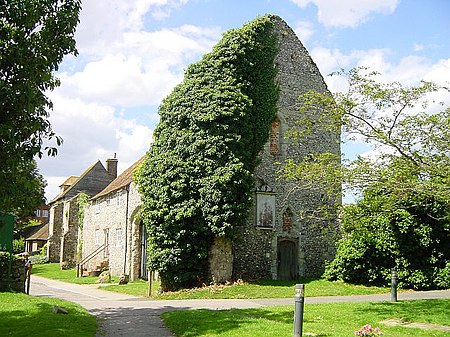
The Archbishop of Canterbury is the senior bishop and principal leader of the Church of England, the symbolic head of the worldwide Anglican Communion and the diocesan bishop of the Diocese of Canterbury. The current archbishop is Justin Welby, who was enthroned at Canterbury Cathedral on 21 March 2013. Welby is the 105th in a line which goes back more than 1400 years to Augustine of Canterbury, the "Apostle to the English", sent from Rome in the year 597. Welby succeeded Rowan Williams.

Addington is a village in the London Borough of Croydon and the historic county of Surrey, located 11.1 miles (18 km) south of Charing Cross and 4 miles south east of Croydon. It is situated to the south of Spring Park, west of Coney Hall, north of New Addington and east of Forestdale and Selsdon.

William Warham was the Archbishop of Canterbury from 1503 to his death.

Lambeth Palace is the official London residence of the Archbishop of Canterbury. It is situated in north Lambeth, London, on the south bank of the River Thames, 400 yards south-east of the Palace of Westminster, which houses the Houses of Parliament, on the opposite bank.

Otford is a village and civil parish in the Sevenoaks District of Kent, England. It lies on the River Darent, 3 miles (5 km) north of Sevenoaks. Otford's four churches are the Anglican Church of St Bartholomew in the village centre, the Otford Methodist Church, the Most Holy Trinity Roman Catholic Church, and the Otford Evangelical Church. By the village pond, also a roundabout, there are pubs, cafes and shops. The village has three schools, Otford Primary School, St Michael's Prep School, and Russell House.

Charing is a village and civil parish in the Ashford District of Kent, in south-east England. It includes the settlements of Charing Heath and Westwell Leacon. It is located at the foot of the North Downs and reaches up to the escarpment.

The Hospital of St Thomas the Martyr of Eastbridge was founded in the 12th century in Canterbury, England, to provide overnight accommodation for poor pilgrims to the shrine of St Thomas Becket. It is now one of the ten almshouses still providing accommodation for elderly citizens of Canterbury and is a grade I listed building.

Aldington is a village and civil parish in the Ashford District of Kent, England. The village centre is eight miles (12 km) south-east of the town of Ashford. As with the village centre, set on a steep escarpment above agricultural Romney Marsh and the upper Stour is Aldington Knoll, which was used as a Roman burial barrow and later beacon, it has a panorama towards the English Channel and of low land such as Dungeness. At the 2011 Census the population included Bonnington.

Bermondsey Abbey was an English Benedictine monastery. Most widely known as an 11th-century foundation, it had a precursor mentioned in the early eighth century, and was centred on what is now Bermondsey Square, the site of Bermondsey Market, Bermondsey, in the London Borough of Southwark, southeast London, England.

Otford Palace, also known as the Archbishop's Palace, is in Otford, an English village and civil parish in the Sevenoaks District of Kent. The village is located on the River Darent, flowing north down its valley from its source on the North Downs.
Gilbert Glanvill or Gilbert de Glanville was a medieval Bishop of Rochester.
Events from the 1500s in England.

Hunsdon House is a historic house in Hunsdon, Hertfordshire, England, northwest of Harlow. Originally constructed in the 15th century, it was most notably the estate of Henry VIII of England. It has been rebuilt several times since then, and is no longer as grand as it was in the Tudor era. It is a Grade I listed building.

The Archbishop's Palace is an historic 14th-century and 16th-century building on the east bank of the River Medway in Maidstone, Kent. Originally a home from home for travelling archbishops from Canterbury, the building is today principally used as a venue for wedding services. The former tithe barn for the palace, now serves as the Tyrwhitt-Drake Museum of Carriages.

All Saints is a parish church in Maidstone, Kent. It is a Grade I listed building, and has been described as the grandest Perpendicular style church in Kent.
Sir Nicholas Haute, of Wadden Hall (Wadenhall) in Petham and Waltham, with manors extending into Lower Hardres, Elmsted and Bishopsbourne, in the county of Kent, was an English knight, landowner and politician.
Sir Edward Wotton (1489–1551) was the Treasurer of Calais and a privy councillor to Edward VI of England.

The Old Palace, also referred to as the Archbishop's Palace, is a historic building situated within the precincts of Canterbury Cathedral. It is the main residence of the Archbishop of Canterbury when in Canterbury.

St Augustine's Abbey was a Benedictine monastery in Canterbury, Kent, England. The abbey was founded in 598 and functioned as a monastery until its dissolution in 1538 during the English Reformation. After the abbey's dissolution, it underwent dismantlement until 1848. Since 1848, part of the site has been used for educational purposes and the abbey ruins have been preserved for their historical value.

Ford Palace was a residence of the Archbishops of Canterbury at Ford, about 6.6 miles (10.6 km) north-east of Canterbury and 2.6 miles (4.2 km) south-east of Herne Bay, in the parish of Hoath in the county of Kent in south-eastern England. The earliest structural evidence for the palace dates it to about 1300, and the earliest written references to it date to the 14th century. However, its site may have been in use for similar purposes since the Anglo-Saxon period, and it may have been the earliest such residence outside Canterbury.
















